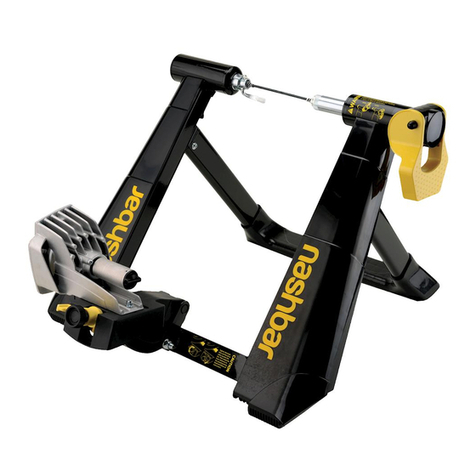
9. Once the extension length of the left side axle support cup is adjusted correctly, make sure it is still oriented with the notch at the top
(to accommodate the QR skewer lever—see Figure 9) and set your bicycle aside. While holding the left axle support cup so it doesn’t
spin, fully tighten the locking ring (E) as shown in Figure 15.
10. Now lift the bicycle into place again, fitting the QR skewer lever into the left side axle support cup. Close the lever handle (D) with the
palm of your hand so that the right side axle support cup presses against the QR skewer nut, clamping the bicycle in place. See Figure
16. Make sure the QR skewer lever and QR skewer nut are fully seated in the axle support cups.
11. Check that the bicycle is securely attached to the trainer by pushing or pulling on the bicycle’s top tube or seat.
12. If the bicycle is not secure, check to see that the QR skewer lever and nut are properly positioned in the axle support cups, and that
the lever handle is in the closed position.
13. Check the position of the rear wheel on the resistance unit roller. While it is not necessary for the rear tire to be perfectly centered on
the roller, you may encounter a clearance issue between the tire and resistance unit if the wheel is not centered (particularly when
using wider tires). To center the wheel on the roller, loosen the resistance unit attachment bolts (H), slide the resistance unit left or right
as necessary, and re-tighten the bolts. See Figure 17.
14. If further adjustment is required to center the wheel, the entire base plate (C) can be adjusted left or right as necessary. Loosen the base
plate attachment bolt (I), slide the base plate left or right as necessary and re-tighten the bolt. See Figure 17.
15. Attach the computer console to the handlebar, preferably near the stem. It may be necessary to remove one or both of the rubber
shims from the console bracket in order to fit larger diameter handlebars.
16. Connect the computer console cable to the console body as shown in Figure 18.
SETUP:
Data generated by the Watt Master Wireless computer will be accurate only if you first perform the following simple set-up procedure. The
set-up screens cannot be accessed while the trainer is in use.
NOTE: In order to provide accurate data, the weight setting (rider weight + bicycle weight) must be programmed for each user. When
switching riders, be sure to adjust the weight setting (see below).
1. To enter the set-up screens, press and hold the right (MODE) button for 4 seconds. See Figure 19.
2. Select metric or imperial units of measure. Press the left (SET) button to select between KM/H, Meters and Kilos, or M/H, Feet and
Pounds (Lb). See Figure 20. Press the MODE button to confirm your selection and proceed to the Weight set-up screen.
3. The weight value will appear on the top line of the display screen, with the right digit flashing. See Figure 21. Note: This value
represents the combined weight of the rider and the bicycle. Enter the combined weight of the rider and bicycle by pressing the SET
button to adjust the flashing digit. Press the MODE button to confirm the value and proceed to the next digit. Repeat this process to set
the remaining digits. When finished, press the MODE button to confirm the value and proceed to the Type set-up screen.
4. The correct Type setting for the Watt Master Fluid Wireless is Type 3. See Figure 22. Press the SET button until “type 3” is displayed.
Press the MODE button to confirm your selection and exit the set-up screens.
USING YOUR TRAINER:
Once the bicycle is mounted to the trainer (see section IV), and the initial set-up is complete (see section V), you’re ready to ride.
1. The weight of the bicycle and rider automatically governs the amount of pressure between the tire and the resistance unit roller, so
there’s no need for an adjusting knob or other device to adjust the pressure.
2. Press either button on the computer console (SET or MODE) or begin pedaling to activate the computer. Current Speed and other data
should immediately appear on the display screen.
NOTE: The Slope and Power readings will vary from rider to rider according to the weight value entered in the set-up process (see section
V). Therefore, the Slope and Power readings may differ for two riders riding at the same speed. For accurate Slope, Power and Elevation
Gain data, remember to reset the weight value when switching riders.
3. Fluid resistance provides smooth, naturally progressive resistance that varies according to your wheel speed. You can use your bicycle’s
gearing the same way you would on the road---lower gearing will generate less resistance (suitable for a warm-up or light recovery
riding) while higher gearing will generate more resistance and a more intense workout.
4. To make your indoor workout as quiet as possible, set the trainer on a trainer mat and use a rear tire with a smooth tread pattern.
5. Riding on an indoor trainer may cause your rear tire to wear more quickly than riding on the road. To minimize tire wear, avoid letting the
tire slip against the roller. Apply power evenly when accelerating, and pedal with a smooth stroke. DO NOT apply the rear brake while
using the trainer. Use a smooth tread tire that is at least 23mm wide and maintain the maximum recommended inflation pressure for
your tire.
COMPUTER CONSOLE
A. SCREENS
Three display screens provide various training data as described below. Use the MODE button to scroll between the three screens. All
screens can be viewed during a ride.
3
Failure to securely attach bicycle to trainer could result in serious injury.
WARNING




























